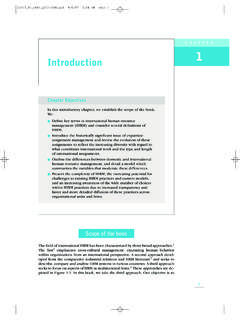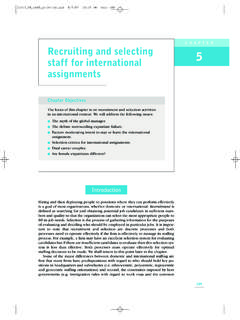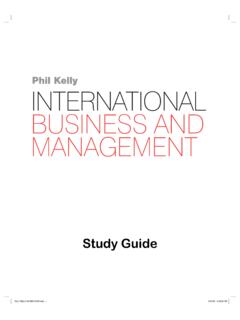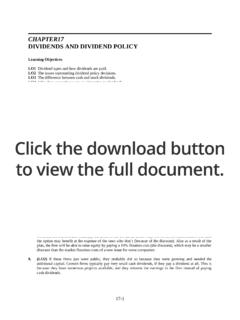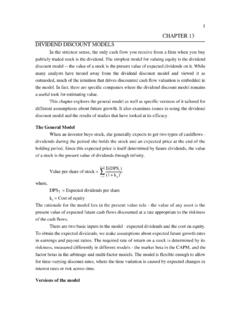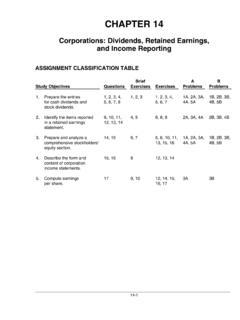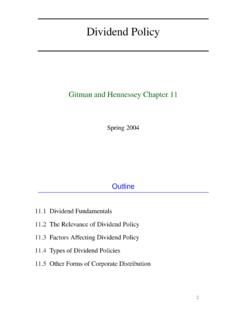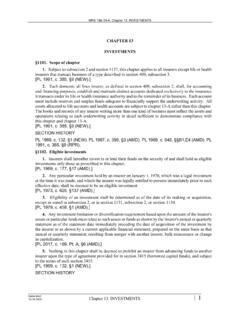Transcription of Chapter 2
1 Chapter 2. Financial Statement and Cash Flow Analysis OPENING FOCUS. Accounting for the numbers Sources: Campbell Harvey, John Graham and Shivaram Rajgopal (2006) The Economic Implications of Corporate Financial Reporting', Journal of Accounting and Accounting is the language of business, but, as we would impact on the earnings per share number in a know, the elements of language can be changed and manner that would surprise the stock market. rearranged to make different stories. So too with Managers would trade off good value projects in accounting information. Studies by professors from favour of smoother earnings. None of these practices Duke University in the USA have shown that execu- are in any way fraudulent or illegal. Rather they tives are adept at making changes to accounting show how closely the managers watch the analysts information, perfectly legally, which can have a who watch the earnings of the companies that the Economics, 40; Rebecca Rosner (2003) Earnings Manipulation in Failing Firms', Contemporary Accounting Research, 20(2): 361 408.
2 Dramatic impact on the bottom line'. managers manage. John Graham and Campbell Harvey, with their By contrast, other research, such as that by colleague Shivaram Rajgopal from Washington Rebecca Rosner, shows that companies that later go University, surveyed over 400 finance executives in into bankruptcy engage pre bankruptcy in large companies. What they discovered was that accounting manipulation of a more substantive companies focus very heavily on bottom line' nature. earnings, particularly earnings per share. The vast This Chapter provides you with the basic skills to majority of companies would defer a good, profitable analyse and interpret, from a finance perspective, project if by taking it on in this accounting period they the accounts of modern corporations. 30. Part 1 The basic tools of finance 1 The scope of corporate finance 2 Financial statement and cash flow analysis Financial statements Cash flow analysis Analysing financial performance using ratio analysis Summary and conclusions 3 Present value LEARNING OBJECTIVES.
3 Part 2 Valuation, risk and return After studying this Chapter you should be able to: 4 Valuing bonds 5 Valuing shares G List and define the key financial statements that firms are required to provide to their 6 The trade-off between risk and return shareholders. 7 Risk, return and the capital asset pricing model G Evaluate a firm's cash flows using its financial statements, including the statement of cash Part 3 Capital budgeting flows. 8 Capital budgeting process and techniques G Calculate and interpret liquidity, activity and 9 Cash flow and capital budgeting debt ratios. 10 Capital cost and capital budgeting G Review the popular profitability ratios and the role of the DuPont system in analysing the firm's returns. Part 4 Capital structure and dividend policy 11 Raising long-term equity financing 12 Capital structure 13 dividend policy Part 5 Additional topics in corporate finance 14 Entrepreneurial finance and venture capital 15 International financial management 16 Risk management 17 Mergers, acquisitions and corporate control SMART FINANCE.
4 Use the learning tools at 32 Part 1 The Basic Tools of Finance A major challenge for the financial manager is measuring the SMART PRACTICES VIDEO relevant benefits and costs associated with both existing and Jon Olson, Vice President of proposed operations. The accounting profession provides a Finance, Intel Corporation variety of standardized' company data, particularly financial At Intel, accounting is a fundamental requirement of a financial analyst.' statements, that frequently serve as a starting point for measuring relevant benefits and costs. See the entire interview at It is often said that accounting is the language of business. Corporate finance relies heavily on accounting concepts and language, but the primary focus of finance professionals and accountants differs significantly. Accountants apply generally accepted accounting principles (GAAP) to construct financial statements accrual-based that attempt to portray fairly how a company has performed in the past.
5 Accountants approach Revenues are recorded generally construct these statements using an accrual-based approach, which means at the point of sale and that accountants record revenues at the point of sale and costs as they are incurred, costs when they are not necessarily when a firm receives or pays out cash. These widely accepted incurred, not necessarily when a firm receives or accounting principles and practices allow corporate financial managers and others, pays out cash. barring fraud, to feel confident with the financial representation contained in audited cash flow approach financial statements. Used by financial professionals to focus In contrast to accountants, financial professionals use a cash flow approach that attention on current focuses more attention on current and prospective inflows (benefits) and outflows and prospective inflows (costs) of cash. The financial manager must convert relevant accounting and tax and outflows of cash. information into cash outflows and cash inflows, which after adjustment for timing differences and risk factors, represent the relevant marginal costs and marginal benefits needed for decision making.
6 This divergence is sometimes also characterized SMART. as an economic (cash flow and finance professional) perspective versus an accounting PRACTICES. perspective. VIDEO. This Chapter describes how financial professionals use accounting information and Howard Millar, Ryanair terminology to analyse the firm's cash flows and financial performance. If accounting The is the language of business, this Chapter can be considered as a primer on how to use problems of the language to say what is relevant to finance. We begin with a brief review of the different major financial statements, then use them to demonstrate some of the key concepts accounting systems. involved in cash flow analysis. We give special emphasis to the firm's cash flows, free cash flows, the classification of inflows and outflows of cash, and the development and See the entire interpretation of statements of cash flows. Then, we discuss some popular financial interview at ratios used to analyse the firm's financial performance.
7 Megginson FINANCIAL STATEMENTS. As noted in Chapter 1, financial managers focus primarily on cash flows rather than on accrual-based accounting data. In spite of this focus, it is important for financial managers to understand financial statements, which serve as a window through which outsiders . investors, lenders and others view the firm's financial performance and position. National governments require public companies to generate financial statements based on widely accepted accounting rules. In the United States, the Securities and Exchange Commission (SEC) is responsible for regulating publicly traded US compa- nies, as well as the nation's stock and bond markets. Every other industrialized country has an agency similar to the SEC, and most developed countries mandate that com- panies generate financial statements that follow international accounting standards (IAS). An important force in the internationalization of accounting standards has been that the SEC has historically insisted that all non-US companies report results based on US rules if they wish to sell their securities directly to US investors.
8 However, the corporate accounting scandals of 2001 and 2002 tarnished the reputation of these rules and enhanced that of IAS. More recently there has been an increased effort to Chapter 2 Financial Statement and Cash Flow Analysis 33. harmonize internationally the rules underlying the presentation of accounting statements. Again, thinking of accounting as a language, the existence of different grammars ways in which the language can be meaningfully put together can cause confusion. Thus, in recent years the International Accounting Standards Board (IASB). has come to the forefront of the debate. In February 2006 the SEC reaffirmed its commitment to convergence and its wish to work with the IASB on the required convergence issues. Thus, the emergence of a world standard for accounting information, a world grammar, appears possible. In this Chapter we use data taken from the Thomson ONE database. Worldscope is a trade name of Thomson Financial, the providers of Banker One Business School Edition, a subscription to which is bundled with this text.
9 In that package are accounts and statements from a large number of companies. However, the material in the pack- age is a small sample of what is generally available from Worldscope, as the entire dataset covers 96 per cent by market value of world equity markets. Worldscope data are harmonized, based on analysis of original statements from companies. This harmonization is undertaken by the analysts at Thomson, and the resulting data are designed to be internationally comparable. Worldscope data are used worldwide by thousands of academics, analysts, bankers and investors. However, despite this de facto world standard, you should realize that the Worldscope data and accounts have no legal basis. A further issue is that the analysts at Worldscope on occasion use slightly different formulae for ratios from those that appear here. On the Thomson ONE site, right click- ing on a number, ratio or element of a statement will show you how it is made up. The key financial statements of any company are (1) the balance sheet, (2) the income statement and (3) the statement of cash flows.
10 Companies may well, in their annual or quarterly reports, use different names. However, the information presented is the same. (In the USA an important further requirement is to provide a statement of retained earnings.) Our concern in this section is to review the information presented in these statements. Throughout, we present the financial statements from the 2006 annual report of LVMH, the French-based luxury goods producer, as an example of the use of standards and methods. Balance sheet A firm's balance sheet presents a snapshot' view of the company's financial position at a specific point in time the financial year-end. By definition, a firm's assets must equal the combined value of its liabilities and shareholders' equity. Phrased differently, either creditors (lenders) or equity investors (owners) finance all of a firm's assets. A balance sheet shows assets on the left-hand side and the claims of creditors and shareholders on the right-hand side. Both assets and liabilities by convention appear in descending order of liquidity, or the length of time it takes for accounts to be converted into cash in the normal course of business.



